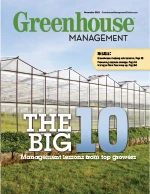 Raymond Cloyd Raymond Cloyd |
Leafminers can be serious insect pests in greenhouses, although this may depend on what crops are being grown, as certain plants such as chrysanthemum and transvaal daisy (Gerbera jamesonii) are more susceptible than others. There are a number of different leafminer species that may be encountered in greenhouses, such as the American serpentine leafminer (Liriomyza trifolii) and the serpentine leafminer (Liriomyza brassicae). The larval stage of leafminers tunnel within leaves (beneath the cuticle), creating either serpentine or blotched mines that may affect the salability of greenhouse-grown crops. Below are general questions associated with leafminers and their management.
A: Adult females puncture the leaf surface with their ovipositor and insert an egg. The small punctures in the leaf created by the ovipositor eventually develop into white spots. However, females don’t lay eggs in every puncture; although they will feed on the plant sap that exudes out of the puncture. Females are capable of laying up to 100 eggs during their two- to three-week lifespan. Eggs hatch in five to six days into larvae that are yellow to brown in color, and 1/8 inch (3.0 millimeters) long when mature. Larvae tunnel below the leaf epidermal layer for approximately two weeks, and then they chew a hole in the leaf and fall to the ground to pupate. After about two weeks, adults emerge from the pupae and fly to new leaves. After mating, females will lay eggs into the leaf tissue. The life cycle from egg to adult takes approximately five weeks to complete, however, this is contingent on temperature. Sometimes multiple generations may be encountered throughout the growing season. Q: How can you tell the difference between leafminer, fungus gnat and shore fly adults? A: Adult leafminers are 1/4-inch long, and black in color with a yellow head. In addition, they possess distinct yellow markings on the body. Fungus gnat adults resemble mosquitoes, and have a “y-shaped” pattern on the forewing. Shore fly adults are robust, and have approximately five white spots on the forewings. Both fungus gnat and shore fly adults are completely black in color. Q: What are some “non-chemical” strategies to avoid, or at least alleviate, problems with leafminers? A: First, remove all weeds from both within and around the greenhouse perimeter, as many weeds serve as a reservoir for leafminers. Second, avoid over-fertilizing crops with high-nitrogen based fertilizers because plants receiving high concentrations of nitrogen tend to be more attractive to female leafminers for egg-laying.
Q: What are some insecticides that may be used in a rotation program to “battle” leafminers? A: There are a number of insecticides registered for use against leafminers with different modes of action including abamectin (Avid), acephate (Orthene), acetamiprid (TriStar), and cyromazine (Citation). Additional insecticides registered for use include imidacloprid (Marathon), dinotefuran (Safari), and thiamethoxam (Flagship). However, these are neonicotinoid-based insecticides and have the same mode of action as acetamiprid (TriStar). Also, the insect growth regulator, novaluron (Pedestal) may be used in rotation programs; however, this insecticide has the same mode of action as cyromazine (Citation); both are chitin synthesis inhibitors. Therefore, these two insecticides should not be used in succession. Q: Are there any biological control agents (i.e. natural enemies) commercially available for use against leafminers? A: Yes, there are two parasitoids: Diglyphus isaea and Dacnusa sibirica. Adult females of D. isaea attack the second instar of leafminer larvae. Dacnusa sibirica females lay eggs directly inside leafminer larva. It is critical to initiate releases of these parasitoids before leafminer populations reach damaging levels. Be sure to check with a supplier to determine the cost and availability of these two biological control agents.
|

Explore the November 2012 Issue
Check out more from this issue and find your next story to read.
Latest from Greenhouse Management
- Anthura acquires Bromelia assets from Corn. Bak in Netherlands
- Top 10 stories for National Poinsettia Day
- Langendoen Mechanical hosts open house to showcase new greenhouse build
- Conor Foy joins EHR's national sales team
- Pantone announces its 2026 Color of the Year
- Syngenta granted federal registration for Trefinti nematicide/fungicide in ornamental market
- A legacy of influence
- HILA 2025 video highlights: John Gaydos of Proven Winners






